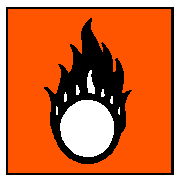International Chemical Safety Cards
| NITRIC ACID | ICSC: 0183 |
NITRIC ACID |
 |
 |
| TYPES OF HAZARD/ EXPOSURE |
ACUTE HAZARDS/ SYMPTOMS |
PREVENTION | FIRST AID/ FIRE FIGHTING |
| FIRE | Not combustible but enhances
combustion of other substances. Gives off irritating or toxic fumes (or gases) in a fire.
|
NO contact with flammable
substances. NO contact with combustibles or organic chemicals. |
In case of fire in the
surroundings: NO FOAM. |
| EXPLOSION | Risk of fire and explosion on
contact with many common organic compounds. |
|
In case of fire: keep drums,
etc., cool by spraying with water. |
| EXPOSURE | |
AVOID ALL CONTACT! |
|
| INHALATION | Burning sensation. Cough.
Laboured breathing. Unconsciousness. Symptoms may be delayed (see Notes). |
Ventilation, local exhaust, or
breathing protection. |
Fresh air, rest. Half-upright
position. Artificial respiration if indicated. Refer for medical attention. |
| SKIN | Corrosive. Serious skin burns.
Pain. Yellow discolouration. |
Protective clothing. |
Remove contaminated clothes.
Rinse skin with plenty of water or shower. Refer for medical attention. |
| EYES | Corrosive. Redness. Pain.
Severe deep burns. |
Face shield or eye protection
in combination with breathing protection. |
First rinse with plenty of water
for several minutes (remove contact lenses if easily possible), then take to a doctor. |
| INGESTION | Corrosive. Abdominal pain.
Burning sensation. Shock. |
Do not eat, drink, or smoke
during work. Wash hands before eating. |
Do NOT induce vomiting. Give
plenty of water to drink. Rest. Refer for medical attention. |
| SPILLAGE DISPOSAL | STORAGE | PACKAGING & LABELLING | ||
| Evacuate danger area! Consult an
expert! Ventilation. Collect leaking liquid in sealable containers. Cautiously
neutralize remainder with sodium carbonate. Then wash away with plenty of water. Do NOT
absorb in saw-dust or other combustible absorbents (extra personal protection: complete
protective clothing including self-contained breathing apparatus). |
Separated from combustible and
reducing substances, bases, food and feedstuffs, organic chemicals. Cool. Dry. Keep in
a well-ventilated room. |
Unbreakable packaging; put
breakable packaging into closed unbreakable container. Do not transport with food and
feedstuffs. O symbol C symbol R: 8-35 S: (1/2-)23-26-36-45 Note: B UN Hazard Class: 8 |
||
| SEE IMPORTANT INFORMATION ON BACK | ||||
|
||||